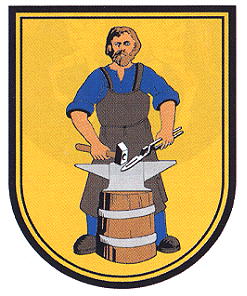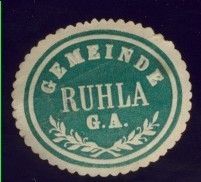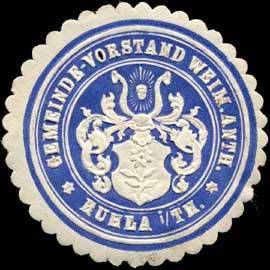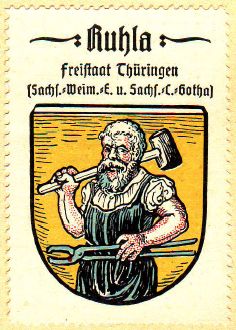Ruhla: Difference between revisions
Knorrepoes (talk | contribs) m (Text replacement - "Literature :" to "'''Literature''':") |
Knorrepoes (talk | contribs) m (Text replacement - "/Arms of " to "/Arms (crest) of ") |
||
| Line 7: | Line 7: | ||
Additions : 1994 Kittelsthal, Thal | Additions : 1994 Kittelsthal, Thal | ||
[[File:ruhla.jpg|center|alt=Wappen von {{PAGENAME}}/Arms of {{PAGENAME}}]] | [[File:ruhla.jpg|center|alt=Wappen von {{PAGENAME}}/Arms (crest) of {{PAGENAME}}]] | ||
{| class="wikitable" | {| class="wikitable" | ||
Revision as of 09:32, 16 November 2022
This page is part of the German heraldry portal Deutsche Wappensammlung |
Heraldry of the World |
|
German heraldry:
|
Selected collector's items from Germany:
|
RUHLA
State : Thüringen
District (Kreis) : Wartburgkreis
Additions : 1994 Kittelsthal, Thal
| German | In Gold ein Schmied hinter einem Amboss stehend, in der Rechten einen Schmiedehammer, in der Linken mit einer Schmiedezange eine Klinge haltend, beides auf dem Amboss aufliegend; der Schmied ist bekleidet mit blauem Hemd, blauer Hose und dunkler Schürze. |
| English | No blazon/translation known. Please click here to send your (heraldic !) blazon or translation |
Origin/meaning
Ruhla was divided in 1640 between Sachsen-Weimar and Sachsen-Gotha. The Sachsen-Weimer part received city rights in 1896 and used as arms a rising sunflower, see seal below. The Sachsen-Gotha used in its seals a smith, taken from a local legend. When on November 30, 1927 the two cities were again united the common seal showed a smith, but without anvil. The present arms were designed in the middle of the 20th century.
| Seal from around 1900 from the Gotha part |
Seal from around 1900 from the Weimar part |
The arms by Hupp in the Kaffee Hag albums +/- 1925 |
Contact and Support
Partners:
Your logo here ?
Contact us
© since 1995, Heraldry of the World, Ralf Hartemink 
Index of the site
Literature: Hupp, O: Kaffee Hag albums, 1920s; Benzing et al, 1984; Ulle, 1998















